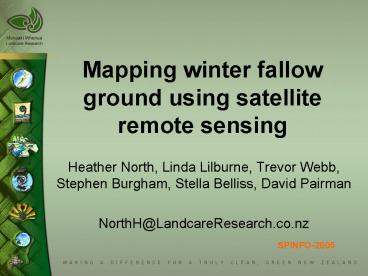Mapping winter fallow ground using satellite remote sensing - PowerPoint PPT Presentation
1 / 14
Title:
Mapping winter fallow ground using satellite remote sensing
Description:
Environmental issue: nitrate leaching in Canterbury farmland ... Landsat 7 imagery of mid-Canterbury, 15 June 2002. Pasture. Bare soil. Dead veg. Forest ... – PowerPoint PPT presentation
Number of Views:31
Avg rating:3.0/5.0
Title: Mapping winter fallow ground using satellite remote sensing
1
Mapping winter fallow ground using satellite
remote sensing
- Heather North, Linda Lilburne, Trevor Webb,
Stephen Burgham, Stella Belliss, David Pairman - NorthH_at_LandcareResearch.co.nz
SPINFO-2005
2
Motivation
- Environmental issue nitrate leaching in
Canterbury farmland - Requires spatial information on winter fallow
ground - Location, extent and timing
SPINFO-2005
3
Detecting winter fallow ground
Landsat 7 imagery of mid-Canterbury, 15 June 2002
SPINFO-2005
4
Method
- Acquire winter sequence of satellite images
- Select image timing to capture important land
states and transitions - Image classification to differentiate between
live vegetation and soil or dead vegetation - Use two or more images to determine timing of
transition to fallow state, and length of time in
fallow state
SPINFO-2005
5
Detecting winter fallow ground
Require more than one image to determine whether
a paddock with low vegetation cover is actually
fallow
- Persistence of low vegetation cover across
several months - OR
- Observation of a step change from vegetated to
non-vegetated (indicating cultivation or
herbicide)
SPINFO-2005
6
Fallow rules
SPINFO-2005
7
Image and field data
- Image sequence in 2002 16 June, 19 August, 22
October - Image sequence in 2003 21 July, 18 August, 15
September, 17 October - Image sequence in 2004 21 May, 7 and 22 July, 24
and 26 September - Image sequence in 2005 starting on 30 May (we
hope) - Co-incident field work with as many scenes as
possible
SPINFO-2005
8
Long winter fallow period
SPINFO-2005
9
Short winter fallow period
SPINFO-2005
10
Fallow 2002
SPINFO-2005
11
Fallow 2003
SPINFO-2005
12
Fallow 2002 and/or 2003
SPINFO-2005
13
Benefits
- Large area coverage but also paddock-level detail
- Mapping is automated, once 1-2 days fieldwork per
image has been completed - Inherently spatial and map-registered so easy to
extract area measurements and locations - Multi-year datasets can be built up to determine
frequency of winter fallow conditions - Will be accompanied by uncertainty information
- Combine with other map registered data, e.g.,
with soil map to calculate fallow ground within
each soil type. - Other possible uses like assessing risk of wind
erosion?
SPINFO-2005
14
Current status/future directions
- Currently completing development of mapping
technique - Discussing fallow ground maps and statistics with
potential users - Potential for operational use?
- Completing draft representation of associated
uncertainty information this year - Trialling uncertainty representation with user
SPINFO-2005































